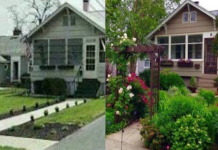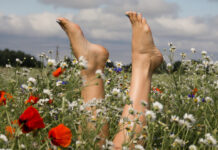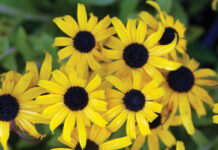For most landscapers without big plowing operations, Spring signals the start of the busy season. While there’s much to do in terms of mowing and maintenance, it’s also the one of the best times for establishing new trees and ornamentals before the heat and stress of summer sets in.

When To Plant: Watch Your Frost Risk
As an avid gardener, I’m a clock watcher. Well, a temperature watcher really. At the first sign of Spring, my (supposed) green thumbs are itchy to get out there and start digging in the dirt. As a landscaper, you’re anxious to get out there and generate income, not to mention please early bird clients. But I do my best to restrain myself since Spring is a fickle season and a 65 degree day can plummet to a freezing night with little warning. Some plants, particularly those showy annuals clients love, simply don’t like freezing temperatures and can wilt or die when exposed to just one frost. So I wait and I watch. I know the risk of frost must be past to dig in many of my pots and plantings. Here in New Jersey, Mother’s Day is the general rule of thumb for when you can start gardening with abandon.
To determine when your region is no longer at risk of frost, the popular gardening site, Dave’s Garden, offers a handy search tool I found when researching the other end of the planting season—first frost and fall establishment. Simply type in your area code at davesgarden.com/guides/freeze-frost-dates and it tells you the basic dates of your growing season based on percentages of frost risk. It even includes charts from weather stations by date and temperature to show percentage risk. For instance, my area’s risk of frost is from October 15 through April 30. It will “almost certainly” receive frost October 29 through April 17 and is “almost guaranteed” to NOT get frost May 13 through October 1.
What To Plant: Zoning In
Besides paying attention to frost risk, knowing your USDA hardiness zone is the next step to successful Spring planting. It’s the standard by which gardeners determine which plants are mostly likely to thrive at a location. After all, a southern region’s perennial may be a northern region’s annual, and nursery tags don’t always make that distinction. A map of the 11 zones in the U.S. can be found here.
Knowing your zone can help steer you and your clients toward reliable plant selections. Search plants by zone at www.gardenia.net/plants/hardiness-zones or filter a plant search by zone with some growers, like Monrovia at www.monrovia.com/plant-catalog. Burpee has a Growing Zone Finder at https://www.burpee.com/findgrowzone where you can enter your zip code, learn average frost dates and growing zone, and then click on a Growing Calendar for planting timelines in your zone for hundreds of vegetables, herbs, fruit, perennials and flowers. For instance, in my zone I can ideally start perennial poppies indoors from late February until early March, transplant them outdoors from early March until late April, or transplant them in the fall from mid September to late October.

Workhorse Plants: Know When To Experiment
Of course, when it comes to the natural world, for every rule, there is an exception. The sun lover that thrives in shade, the hybrid that starts reverting to a parent plant, the rosemary variety that sometimes overwinters in a frost zone. So while planting after frost risk and following zone recommendations can provide reliable results when incorporating expensive trees and shrubs, experienced landscapers know there’s always going to be some varieties that are more cold hardy, heat hardy, or flexible than others. These are the varieties that you can try to plant a bit early for Spring appeal that keeps clients happy.
While it can take years before you have your stable of these “reliables” based on your own experiences, don’t be afraid to ask around. And remember, horticultural plants are always evolving and improving, becoming hardier, more attractive, etc. Observe what other landscapers are planting, and at the nursery, if an expert isn’t on hand to ask, see if the plant is located outdoors or in a greenhouse. If outdoors, is it on a mobile cart that is brought in at night when temperatures dip? Since plants are a nursery’s precious revenue, they won’t be taking any chances with their stock. Paying attention to a plant’s placement in the nursery yard can provide clues as to whether the plant is ready for a client’s yard.
Another way to work around the “rules” is using plants in non-traditional ways. In my zone, colorful vegetables like swiss chard and lettuces, and herbs like thyme and oregano are cold hardy; perennial heuchera, hellebore, and carex grasses can be “evergreen;” annuals like Dusty Miller, geranium, and pansies can be frost tolerant; and succulents can be surprisingly durable. Combining categories like vegetables with perennials together in unexpected, colorful mixes, gives you more variety for early Spring plantings and for clients craving color and interest as early as possible.
Where To Plant: Know A Site’s Sun, Shade & Water
We all know the rule: the right plant in the right place. Unfortunately, it can be harder than it sounds. One thing to pay attention to is the geographic alignment of the client’s site (i.e. which direction does it face?), noting large trees and structures and which way the shade will fall at different times of day. Also note what areas get full sun—and is it bright morning sun or blistering afternoon sun? My house, for instance, faces north and when a hot afternoon sun hits the western side of my property in August, the plants in that area sizzle. It would be easy to believe in the cooler days of Spring that a “part sun” plant might survive. But I know after years of experience, it won’t. Remember when you plant a tree or perennial in Spring, you’re not just planting FOR Spring, but for all seasons and all their extremes.

Besides sun and shade patterns, observe fences or structures that shield from weather elements like high winds or snow, as well as areas that get more water than others from gutter runoff, sump pump discharge, a slope, or even an underground stream. During a heavy rain, the water pools in my yard in certain locations. As a result, I planted a Dura-Heat® river birch in one of the wettest areas. Not only is the tree beautiful, but judging by its enormous size, it soaks up a lot of water that once would have lingered near my house foundation. Conversely, when I redirected my sump pump discharge to a dry creek bed bordering my garden, I effectively killed my pear tree with too much water. Lesson learned.
How To Plant: Know The Soil
Landscapers know the importance of good soil, rich in nutrients, because it’s such a determining factor in creating a lush, green lawn. Soil samples, taken two to three weeks before planting—or even better, taken a few months in advance, will determine the lime and fertilizer requirements. Below are further recommendations summarized from a University of Georgia Extension’s Bulletin entitled: Soil Preparation and Planting Procedures for Ornamental Plants in the Landscape:
- If planting several ornamentals, they grow more uniformly if planted in a well prepared bed, rather than individual holes. Begin by deep tilling to a depth of 12″ to 15″. Then incorporate about one pound (two cups) of an 8% to 10% nitrogen fertilizer, such as 8-8-8 or 10-10-10, over every 100 square feet of bed area. (Only incorporate lime if needed.)
- For planting areas with annuals and herbaceous perennials, after deep tilling, elevate the bed 6″ to 12″ with soil amendments. While the best amendment depends on soil type, a combination of composted organic matter, composted animal manure, and large-particle sand (such as Lithonia granite), are frequently used to amend beds. If bagged organic amendments are used, apply one 40 pound bag per 100 square feet of bed area and incorporate it to a depth of 6″ to 8″. Slow-release fertilizers, such as Osmocote®, are also excellent for flowerbeds. After planting, apply about 3″ of mulch. Finally, water thoroughly.
- To plant balled and burlapped trees, cut any wire or cord from the trunk and pull back the burlap from the top 1/3 of the root ball to allows feeder roots to grow. When planting in poorly drained soils, remove the burlap completely. For trees or shrubs grown in fabric bags, be sure to always remove the entire bag.
Then dig a hole as deep as the root ball, but at least twice as wide. (Some landscapers plant the top of the root ball 1″ to 2″ above grade if they know the soil is likely to settle.) Unlike garden bed planting, don’t amend the soil in a planting hole; it can act like a sponge, causing the roots to stay too wet. Instead, water the planting hole as you backfill with the same soil removed. Use your hand (not your feet) to firm the soil and continue to water thoroughly when finished, then yet again several hours later. During planting, slow-release or liquid fertilizers can be added to the hole, but granular general-purpose fertilizers, such as 8-8-8 or 10-10-10, can damage tender roots. Shaping a small ring of soil, two to three inches high, along the perimeter of the hole forms a saucer to direct water to roots and prevent runoff. Finally, apply a 3″ layer of mulch.
For more information on planting specifics, check out Bulletin 932 from the University of Georgia Extension.
Why Plant? Listening To The Environment
Despite following all the recommendations above, plant still die. I call my garden a “survival of the fittest.” I’ve killed my share of plants, but I’ve learned a lot in the process. Frankly, if a plant requires too much soil amendment, or pesticides, or special care, I’m not going to coddle it—and neither will the majority of landscape clients. Not that I haven’t meticulously removed bagworms from an arborvitae, or treated my ninebark for powdery mildew, but it turns out my no-fuss attitude is actually far better for the environment. In an era of climate change, soaring temperatures, drought, dying pollinators, and decreasing biodiversity, it’s understandable that we are turning to native plants, water wise solutions, and plant choices that work in harmony, rather than against, the natural ecosystem. Ultimately, if a plant doesn’t naturally want to live in my yard—or your clients’—without extreme measures, maybe it shouldn’t.
Menapace is managing editor of Turf. An avid gardener, she has worked as a Park naturalist and floral designer, and has been a green industry writer for nearly 30 years.
Do you have a comment? Share your thoughts in the Comments section below or send an e-mail to cmenapace@groupc.com.











![[VIDEO] Dickies®: Discover Workwear That’s Anything But Uniform](https://turfmagazine.com/wp-content/uploads/2023/06/1647663814-4b1a2a7742790a9b1e97a3b963477850192e1d6a9dfba9b07214a77bae25d6e3-d-218x150.jpg)






























![[VIDEO] Dickies®: Discover Workwear That’s Anything But Uniform](https://turfmagazine.com/wp-content/uploads/2023/06/1647663814-4b1a2a7742790a9b1e97a3b963477850192e1d6a9dfba9b07214a77bae25d6e3-d-324x160.jpg)